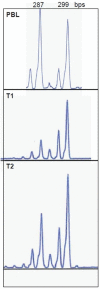Synchronous pleural and peritoneal malignant mesothelioma: a case report and review of literature
- PMID: 24966960
- PMCID: PMC4069956
Synchronous pleural and peritoneal malignant mesothelioma: a case report and review of literature
Abstract
The coexistence of mesothelioma and other primary malignancies has been previously reported in literature, but the finding of a pleural mesothelioma with a synchronous peritoneal mesothelioma has not been reported so far. We report a case of a 58-years-old woman that came to our attention for the incidental finding of an inguinal mass. Fine-needle biopsies of the mass and a thoracoscopy with pleural biopsies were performed, after imaging studies showed pleural thickenings suspicious for malignancy. Histological morphology and growth pattern were similar in both cases. Both tumors stained for calretinin, but only the pleural mesothelioma showed positivity for Wilms-Tumor 1 antibody. We tried to demonstrate with molecular biology techniques whether they were synchronous or one was the metastasis of the other, but our studies did not give informative results. The prognosis in this case is poor, and after 6 months the patient is still following a chemotherapy regimen, which is the only practicable approach given the extent of the disease.
Keywords: EGFR; Mesothelioma; X-chromosome inactivation; peritoneal malignancy; pleural malignancy.
Figures



References
-
- Travis WD, Brambilla E, Muller-Hermelink HK, Harris CC. Pathology and Genetics of Tumours of the Lung, Pleura, Thymus and Heart. Lyon: IARC Press; 2004. Chapter 2: Tumors of the pleura; pp. 25–144.
-
- Churg A, Cagle PT, Roggli VL. Tumors of the serosal membranes, 4th series. American Registry of Pathology. 2006. Diffuse malignant tumors of the serosal membranes; pp. 33–72.
-
- Allen TC, Moran C. Synchronous pulmonary carcinoma and pleural diffuse malignant mesothelioma. Arch Pathol Lab Med. 2006;130:721–724. - PubMed
-
- Raju B, Kotilingam K, Ravindra Babu G, Ramakoteswarao N. Pleural mesothelioma with inguinal lymphnode metastasis - a case report. Lung India. 1989;1:44–47.
-
- Attanoos RL, Thomas DH, Gibbs AR. Synchronous diffuse malignant mesothelioma and carcinomas in asbestos-exposed individuals. Histopathology. 2003;43:387–392. - PubMed
Publication types
MeSH terms
Substances
LinkOut - more resources
Full Text Sources
Medical
Research Materials
Miscellaneous
